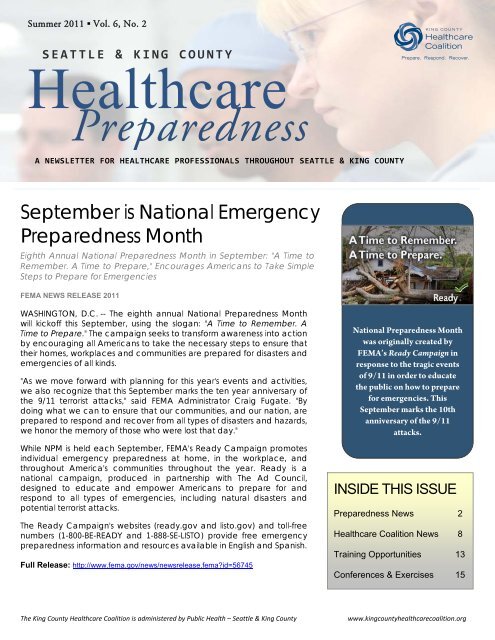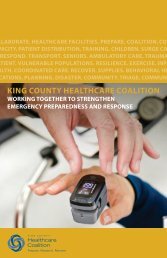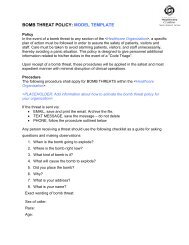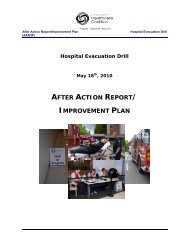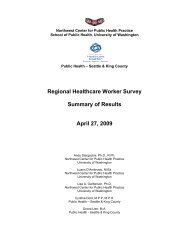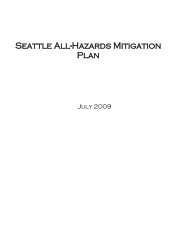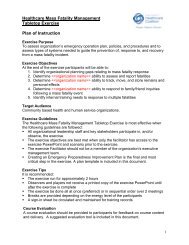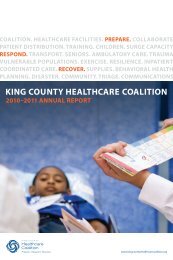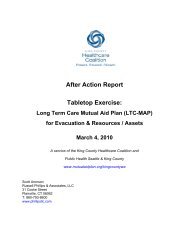Preparedness - KCHC
Preparedness - KCHC
Preparedness - KCHC
You also want an ePaper? Increase the reach of your titles
YUMPU automatically turns print PDFs into web optimized ePapers that Google loves.
Summer 2011 ▪ Vol. 6, No. 2<br />
SEATTLE & KING COUNTY<br />
Healthcare<br />
<strong>Preparedness</strong><br />
A NEWSLETTER FOR HEALTHCARE PROFESSIONALS THROUGHOUT SEATTLE & KING COUNTY<br />
September is National Emergency<br />
<strong>Preparedness</strong> Month<br />
Eighth Annual National <strong>Preparedness</strong> Month in September: "A Time to<br />
Remember. A Time to Prepare," Encourages Americans to Take Simple<br />
Steps to Prepare for Emergencies<br />
FEMA NEWS RELEASE 2011<br />
WASHINGTON, D.C. -- The eighth annual National <strong>Preparedness</strong> Month<br />
will kickoff this September, using the slogan: "A Time to Remember. A<br />
Time to Prepare." The campaign seeks to transform awareness into action<br />
by encouraging all Americans to take the necessary steps to ensure that<br />
their homes, workplaces and communities are prepared for disasters and<br />
emergencies of all kinds.<br />
"As we move forward with planning for this year's events and activities,<br />
we also recognize that this September marks the ten year anniversary of<br />
the 9/11 terrorist attacks," said FEMA Administrator Craig Fugate. "By<br />
doing what we can to ensure that our communities, and our nation, are<br />
prepared to respond and recover from all types of disasters and hazards,<br />
we honor the memory of those who were lost that day."<br />
While NPM is held each September, FEMA's Ready Campaign promotes<br />
individual emergency preparedness at home, in the workplace, and<br />
throughout America's communities throughout the year. Ready is a<br />
national campaign, produced in partnership with The Ad Council,<br />
designed to educate and empower Americans to prepare for and<br />
respond to all types of emergencies, including natural disasters and<br />
potential terrorist attacks.<br />
The Ready Campaign's websites (ready.gov and listo.gov) and toll-free<br />
numbers (1-800-BE-READY and 1-888-SE-LISTO) provide free emergency<br />
preparedness information and resources available in English and Spanish.<br />
Full Release: http://www.fema.gov/news/newsrelease.fema?id=56745<br />
National <strong>Preparedness</strong> Month<br />
was originally created by<br />
FEMA’s Ready Campaign in<br />
response to the tragic events<br />
of 9/11 in order to educate<br />
the public on how to prepare<br />
for emergencies. This<br />
September marks the 10th<br />
anniversary of the 9/11<br />
attacks.<br />
INSIDE THIS ISSUE<br />
<strong>Preparedness</strong> News 2<br />
Healthcare Coalition News 8<br />
Training Opportunities 13<br />
Conferences & Exercises 15<br />
The King County Healthcare Coalition is administered by Public Health – Seattle & King County<br />
www.kingcountyhealthcarecoalition.org
Save Lives<br />
and Build<br />
Resilience<br />
Tale of<br />
Our Cities<br />
Planning for an<br />
Interdisciplinary<br />
Response to<br />
Terrorist Use<br />
of Explosives<br />
Please join us for<br />
this<br />
unprecedented<br />
gathering of<br />
experts<br />
from around the<br />
world who will<br />
share how their<br />
first-hand<br />
experience<br />
of terrorist events<br />
can benefit your<br />
local planning.<br />
Invited speakers will<br />
include exper ts from<br />
Israel, Pakistan,<br />
India, and London.<br />
MARK YOUR<br />
CALENDARS:<br />
Monday<br />
Nov. 7, 2011<br />
DoubleTree<br />
Seattle Airport<br />
Department of Homeland Security Progress<br />
Fulfilling 9/11 Commission Recommendations<br />
Department of Defense News Release<br />
WASHINGTON—Seven years after the release of the 9/11 Commission report, Secretary<br />
of Homeland Security Janet Napolitano released a Department of Homeland Security<br />
(DHS) report highlighting the significant progress that DHS, along with its many<br />
partners, have made in fulfilling specific recommendations by the 9/11 Commission to<br />
build a country that is stronger, safer and more resilient.<br />
“September<br />
“Ten years after the September 11, 2001 attacks, America<br />
is stronger and more resilient than ever before, but threats<br />
from terrorism persist and challenges remain,” said<br />
Secretary Napolitano. DHS and its many partners across<br />
the Federal government, public and private sectors, and<br />
communities across the country and around the world<br />
have worked since 9/11 to build a new homeland security<br />
enterprise to better mitigate and defend against dynamic<br />
threats, minimize risks, and maximize the ability to respond<br />
to and recover from attacks and disasters of all kinds.<br />
To view the Department’s full report please visit:<br />
www.dhs.gov/9-11-progress-report<br />
will mark the ten<br />
year anniversary<br />
of 9/11; we will<br />
remember those<br />
lost, honor our first<br />
responders, and<br />
renew our<br />
commitment to<br />
prepare and plan<br />
for emergencies.”<br />
Terror Threat 'Most Heightened' Since 9/11<br />
ABC NEWS | By Jason Ryan and Devin Dwyer<br />
The threat of terrorism is at "its most heightened state" since the 9/11 attacks nearly a<br />
decade ago, U.S. Homeland Security Secretary Janet Napolitano said recently. “The<br />
terrorist threat facing our country has evolved significantly in the last ten years -- and<br />
continues to evolve -- so that, in some ways, the threat facing us is at its most<br />
heightened state since those attacks," she said before the House Homeland Security<br />
Committee. Her comments were a sobering reminder that the potential of another<br />
attack is real and growing, most notably from individuals radicalized inside the United<br />
States, despite elaborate security measures implemented by the government since<br />
2001. "One of the most striking elements of today's threat picture is that plots to attack<br />
America increasingly involve American residents and citizens," Napolitano said.<br />
Full Article: http://www.infowars.com/terror-threat-most-heightened-since-911-napolitano-says/<br />
Nationwide Test of the Emergency Alert System<br />
FEMA NEWS RELEASE<br />
The U.S. Department of Homeland Security's Federal Emergency Management<br />
Agency and the Federal Communications Commission (FCC) will conduct the first<br />
nationwide test of the Emergency Alert System. The nationwide test will occur on<br />
Wednesday, November 9 at 11:00am PST and may last up to three and a half minutes.<br />
The EAS is a national alert and warning system established to enable the President of<br />
the United States to address the American public during emergencies. A national test<br />
will help the federal partners and EAS participants determine the reliability of the<br />
system and its effectiveness in notifying the public of emergencies and potential<br />
dangers nationally and regionally.<br />
2
Enabled Mobile Devices Will Receive Emergency<br />
Alerts with Potentially Life Saving Messages<br />
FEMA NEWS RELEASE<br />
Mayor Michael Bloomberg, FEMA Administrator Craig Fugate, FCC Chairman, top<br />
executives from AT&T, Sprint, T-Mobile and Verizon and others convened at the World<br />
Trade Center site to announce PLAN--the Personal Localized Alerting Network. PLAN is a<br />
free service that will allow customers with an enabled mobile device to receive<br />
geographically-targeted, text-like messages alerting them of imminent threats to safety in<br />
their area. This service will be available in New York City by the end of 2011, at least<br />
two calendar quarters before the rest of the nation.<br />
PLAN ensures that emergency alerts will not get stalled by user congestion, which can<br />
happen with standard mobile voice and texting services. Authorized government officials<br />
can send messages, which participating wireless providers then push using their cell<br />
towers to enabled mobile devices in a targeted geographic area. “This new technology<br />
could become a lifeline for millions of Americans and is another tool that will strengthen<br />
our nation’s resilience against all hazards” said FEMA Administrator Fugate.<br />
When PLAN is operational, customers in an area affected by an emergency who have a<br />
PLAN-capable mobile device will receive an alert of ninety characters or less. Consumers<br />
will receive three types of alerts from PLAN: (1) alerts issued by the President; (2) alerts<br />
involving imminent threats to safety of life; and (3) Amber Alerts.<br />
Participating carriers may allow subscribers to block all but Presidential alerts.<br />
SMS Text<br />
Messaging<br />
for Public<br />
Health<br />
Emergencies<br />
DID YOU KNOW…<br />
According to<br />
CTIA Wireless<br />
Association, Billions<br />
of text messages<br />
are sent every day<br />
in the US, and the<br />
vast majority of<br />
people have a cell<br />
phone in their<br />
pocket that can<br />
send and receive<br />
text messages.<br />
More on PLAN: blog.fema.gov/2011/05/plan-another-part-of-publics-emergency.html. Public Health –<br />
Full Article: http://www.fema.gov/news/newsrelease.fema?id=54888<br />
HHS Toolkit of Public Health Emergency Text<br />
Messages<br />
US Department of Health and Human Services Press Release<br />
A new toolkit of prepared cell phone text messages advising<br />
people how to protect their health after a disaster is available<br />
now through the U.S. Department of Health and Human<br />
Services. These messages support state and local emergency<br />
managers in disaster response and are available online at<br />
http://emergency.cdc.gov/disasters/psa.<br />
The toolkit currently features text messages relevant to<br />
hurricanes, floods and earthquakes.<br />
Full Article:<br />
http://www.hhs.gov/news/press/2011pres/06/20110609b.html<br />
911 will Soon Accept Texts, Photos, Video<br />
Mashable.com | Erica Swallow<br />
The FCC wants Americans to be able to send texts, videos, photos and location data to<br />
911. An FCC plan will update the technology that powers the current 911 emergency<br />
response system. The official project name is Next Generation 911-NG911. The plan will<br />
enable the transmission of text messages, voice calls, videos and photos, as well as<br />
automatic location information. The FCC hopes that such a plan will enable emergency<br />
responders to respond faster while also giving individuals more options for contacting<br />
911.<br />
Seattle & King<br />
County have<br />
launched an<br />
important new<br />
initiative to<br />
investigate how<br />
this powerful<br />
mobile technology<br />
can be best used<br />
to protect and<br />
promote the<br />
health of our<br />
residents,<br />
particularly in an<br />
emergency:<br />
To See the full<br />
Report Visit:<br />
http://www.kingcounty.go<br />
v/healthservices/health/pr<br />
eparedness/texting.aspx#o<br />
verview<br />
3<br />
43
How a Vancouver Hospital Readied<br />
for the Hockey Riots<br />
CTV NEWS | Angela Mulholland<br />
A police car burns during a riot in<br />
downtown Vancouver,<br />
Wednesday, June 15, 2011.<br />
(Geoff Howe / THE CANADIAN PRESS)<br />
Remembering this spring's Stanley Cup riots in Vancouver can still make<br />
many Canadians cringe. The four hours of destruction that rained down<br />
on the city stunned the whole country. But St. Paul's Hospital in<br />
Vancouver's downtown had actually had been preparing for them since<br />
long before the playoffs began. For each playoff game, as many as<br />
75,000 people had filled the downtown to watch on giant screens. By the<br />
time Game 7 rolled around, tension was mounting and hospital staff<br />
knew that even with a win, there was going to be trouble.<br />
By 10 p.m. that night, the riots were well underway and the injuries<br />
pouring in. But St. Paul's was ready to handle them, says Jeanette<br />
Beattie, the hospital's head of emergency preparedness.<br />
Like many large hospitals in Canada, St. Paul's has staff whose sole job is to plan the hospital's response to<br />
disasters, manmade or otherwise. Beattie says on the night of the hockey riots, St. Paul's was able to make use<br />
of all the training and preparations done ahead of the Vancouver Olympics. They had practiced what they'd<br />
do by running mock scenario drills. One major exercise they practiced involved police, paramedics, and 85<br />
volunteers in full costume and "moulage" makeup pretending to be injured passengers from a plane crash.<br />
Beattie says in all, 140 groups took part, learning how to coordinate an efficient response that would allow the<br />
injured to be transported and treated quickly.<br />
On the night of the riots, things started to get ugly around 8<br />
p.m., when spectators started throwing bottles and burning<br />
Boston Bruins jerseys. By 10 p.m., there were so many injured<br />
pouring into St. Paul's and nearby Vancouver General Hospital,<br />
both declared a Code Orange -- hospital code for an influx of<br />
mass casualties. Staff were asked not to go home after their<br />
shifts but to help out in the emergency department in whatever<br />
way they could. Nine physicians were brought into the ER,<br />
instead of the usual two, and more security staff were called in.<br />
A contingent of nurses was assigned to run a pre-arranged<br />
decontamination station outside the ER, for the tear gas injuries.<br />
They set out garbage bins filled with water so people could<br />
dunk their heads to relieve the burning from the gas. By keeping<br />
the tear gas injuries outside, staff ensured the ER itself was never<br />
contaminated with the powder.<br />
Tear gas was expelled very close to the hospital,<br />
forcing an emergency shut off of St. Paul’s HVAC<br />
system; meaning that the hospital's operating rooms<br />
were no longer "negative pressure rooms"<br />
(Geoff Howe / THE CANADIAN PRESS)<br />
Other staff operated a triage station in a courtyard outside the emergency department to treat those with<br />
minor injuries. Inside, doctors dealt with the more serious injuries, such as stab wounds, burns, and broken limbs.<br />
Other nurses were also asked to help patients who were having trouble with the psychological impact of the<br />
night. "People really were traumatized. There was the fear, the pepper spray, boyfriends hurt, girlfriends hurt. So<br />
we had two psychosocial leads come in," says Beattie.<br />
In all, 147 injured rioters and bystanders headed to St. Paul's ER -- most of them arriving in a two-hour period --<br />
about twice as many as the emergency department typically sees in a night. Only four had to be admitted.<br />
Beattie says the system ran smoothly amid the chaos and pretty much according to plan. The only thing that<br />
the hospital had not prepared for was the drifting tear gas.<br />
That lesson will likely be integrated into the hospital's planning as it gets ready for the next disaster, because as<br />
Beattie points out, when it comes to disaster management, "the planning never stops."<br />
Full Article: http://www.ctv.ca/CTVNews/Canada/20110805/vancouver-riots-hospital-preps-110807/<br />
HEALTHCARE PREPAREDNESS Seattle & King County 4
In Joplin's Tornado Emergency, Electronic<br />
Health Records Were Key<br />
NPR BLOG| Alan Greenblatt<br />
In the days following the devastating tornado in Joplin, Mo., one of the reports widely<br />
shared locally was news of X-rays having been blown all the way to Springfield, some<br />
70 miles away. The hospital that lost those X-rays, St. John's Regional Medical Center,<br />
was badly damaged by the storm and has been shut down. But it still has its patient<br />
records intact. The hospital had completed its conversion to electronic health records<br />
on May 1 — three weeks before the storm.<br />
A mobile field hospital has been set up in the St. John's parking lot, complete with CT<br />
scans and surgical theaters. And St. John's patients going to facilities elsewhere are<br />
finding that their prescriptions and treatment schedules are available to providers.<br />
"The bottom line is, if we didn't have the electronic health records, we would not be<br />
back operational today," says Mike McCreary, chief of technology services for the<br />
Sisters of Mercy Health System, which runs St. John's.<br />
The experience in Joplin suggests that patient records may be more securely<br />
preserved electronically than on paper or on film. But you still need power to access<br />
them.<br />
Full Article: http://www.npr.org/blogs/health/2011/06/12/137106957/in-joplins-tornado-emergencyelectronic-health-records-were-key<br />
Majority of U.S. Hospitals Meet All-Hazards<br />
<strong>Preparedness</strong> Measures<br />
HHS Press Release<br />
More than 76 percent of hospitals participating in the National<br />
Hospital <strong>Preparedness</strong> Program (HPP) met 90 percent or more<br />
of all program measures for all-hazards preparedness in 2009,<br />
according to a report released by the U.S. Department of<br />
Health and Human Services’ Assistant Secretary for<br />
<strong>Preparedness</strong> and Response.<br />
From Hospitals to Healthcare Coalitions: Transforming Health<br />
<strong>Preparedness</strong> and Response in Our Communities, the<br />
program’s first state-by-state report, identifies the advances<br />
that states have made in preparing hospitals for all types of<br />
disasters. The report also discusses the next steps the program<br />
will take to boost community resilience.<br />
From<br />
Hospitals to<br />
Healthcare<br />
Coalitions:<br />
Transforming<br />
Health<br />
<strong>Preparedness</strong><br />
& Response in<br />
Our<br />
Communities<br />
The Hospital<br />
<strong>Preparedness</strong><br />
Program (HPP) has<br />
become a critical<br />
component of<br />
community<br />
resilience and<br />
enhancing the<br />
response<br />
capabilities of our<br />
healthcare system.<br />
The report<br />
describes the<br />
achievements of<br />
our State partners<br />
in building<br />
healthcare<br />
preparedness<br />
across the nation.<br />
To see the<br />
agreement visit:<br />
http://www.phe.gov/Pre<br />
paredness/planning/hp<br />
p/Documents/hpp-<br />
healthcarecoalitions.pdf<br />
All states, eight U.S. territories and four large metropolitan areas participate in the<br />
cooperative agreement grant program, which provides federal funds, technical<br />
assistance, and guidelines for hospital preparedness. Of the more than 6,300 hospitals<br />
across the nation, more than 85 percent take advantage of the program.<br />
The report suggests that, as an increasing number of hospitals meet performance<br />
measures program, participants also focus on building coalitions within communities<br />
so that hospitals, government agencies, non-government organizations, businesses,<br />
and community residents work as a team to prepare for and respond to disasters. The<br />
report recommends that these coalitions involve all populations within communities,<br />
including children, pregnant women, the elderly, and those who are vulnerable in<br />
other ways.<br />
Full Release: http://www.hhs.gov/news/press/2011pres/05/20110505a.html<br />
5
Bacteria Detected by Air Monitor in East King County:<br />
No Human Health Effects<br />
Subsequent test negative; findings consistent with naturally occurring bacteria<br />
WA Department of Health & Public Health-Seattle & King County News Release<br />
A federal air monitoring system<br />
designed to monitor threats to human<br />
health in the Puget Sound region<br />
recently identified bacteria that can<br />
cause tularemia, an infectious disease,<br />
in a daily air sample taken from a<br />
monitoring station in east King County.<br />
Bacteria levels were low, close to the<br />
detection limit, and a subsequent test<br />
found no bacteria present. Since the<br />
air monitoring system was established<br />
nationally in 2003, similar positive test<br />
results due to naturally-occurring<br />
bacteria have been common in other<br />
areas of the country.<br />
The bacteria, Francisella tularensis, are<br />
found throughout Washington,<br />
commonly carried by rabbits, squirrels,<br />
and other rodents. People rarely are<br />
infected with tularemia; only two cases<br />
have been identified in Washington this<br />
year. Typically, Washington sees<br />
between one and 10 human cases per<br />
year.<br />
State and local officials agree the<br />
detection shows the public health<br />
response plan worked.<br />
The air monitors detected bacteria<br />
even though levels were low, state<br />
and local health teamed with law<br />
enforcement and confirmed there’s<br />
no threat, and research showed no<br />
signs of illnesses reported in the area.<br />
Notice has been sent to area health<br />
care providers.<br />
The air monitoring system that<br />
detected the bacteria is called<br />
BioWatch, a federal program that<br />
operates nationwide in major<br />
metropolitan areas. The program<br />
routinely collects air samples and<br />
tests them for trace amounts of<br />
biologic material that could be due<br />
to either an intentional attack or a<br />
natural occurrence. There are several<br />
monitors located throughout the<br />
Puget Sound area in King, Pierce, and<br />
Snohomish counties. This is the first<br />
time that a sample from the Puget<br />
Sound area has tested positive.<br />
Locations of the monitors are<br />
withheld for security purposes.<br />
Full Release:<br />
http://www.doh.wa.gov/Publicat/2011_news/11-112.htm<br />
Francisella tularensis is very<br />
infectious. A small number<br />
(10-50 or so organisms) can<br />
cause disease. If F. tularensis<br />
were used as a weapon, the<br />
bacteria would likely be made<br />
airborne for exposure by<br />
inhalation. People who inhale<br />
an infectious aerosol would<br />
generally experience severe<br />
respiratory illness, including<br />
life-threatening pneumonia<br />
and systemic infection, if they<br />
are not treated. ~ CDC<br />
Radiation Levels Mapped in Puget Sound by Helicopter<br />
WA Department of Health News Release<br />
Lessons from the nuclear incidents in Fukushima, Japan show the value of a<br />
project to measure background radiation levels in several parts of the state. A<br />
low-flying helicopter will gather radiological readings this summer around<br />
Puget Sound. Radiation detection equipment mounted in a helicopter will<br />
measure “gamma emitters” like cesium and radioactive iodine — materials<br />
that would likely increase in a radiation emergency. This kind of material<br />
releases X-rays, or gamma radiation, a type that can be easily measured from<br />
the helicopter. State radiation experts expect to find natural radioactivity and<br />
material produced by licensed radioactive material users such as hospitals.<br />
Mapping the normal amounts and location of radioactive material will provide<br />
a baseline for comparison to assess contamination if there were a nuclear<br />
incident like the events in Fukushima.<br />
The Washington State Department of Health is overseeing the project as the U.S. Department of Energy’s Remote<br />
Sensing Laboratory Aerial Measurement System conducts the flyover. Information about the project is available<br />
on the agency Aerial Radiological Survey website www.doh.wa.gov/ehp/rp/rep/aerial.htm .<br />
HEALTHCARE PREPAREDNESS Seattle & King County<br />
6
FEMA Won't Pick Up $30<br />
Million Tab to Prepare<br />
for Flooding<br />
SEATTLE TIMES │Craig Welch<br />
They lined up more than 100,000 feet of giant<br />
sandbags, relocated offices, installed emergency<br />
pipes and generators and even elevated<br />
streetlights to keep them dry and visible.<br />
King County, the State and four area cities spent more than $30 million in 2009 because<br />
the federal government said it might have to flood the Green River Valley so the<br />
damaged Howard Hanson Dam wouldn't blow. But the Federal Emergency<br />
Management Agency (FEMA) still refuses to help foot the bill, arguing that there was<br />
never an imminent threat. "That's just baffling to us," said Hillman Mitchell, King County's<br />
emergency-management director. "Uniformly, everyone has been surprised by these<br />
denials."<br />
The dispute dates back to January 2009, when a series of storms seriously weakened the<br />
right abutment of the Howard Hanson Dam. It wasn't until late that summer that Col.<br />
Anthony Wright, with the U.S. Army Corps of Engineers in Seattle, said he feared that if<br />
future rains filled the reservoir behind the dam to capacity the structure would fail. He<br />
said he believed there was a 1 in 3 chance he might have to inundate Auburn, Kent,<br />
Renton and Tukwila to avoid a more deadly catastrophe.<br />
Because that part of South King County is home to 26,000 residents and 100 million<br />
square feet of buildings, local governments began preparing for the worst. But even<br />
though the White House declared the region a disaster area during the January storms,<br />
FEMA said the new threat that emerged that summer wasn't actually urgent enough.<br />
"The applicants' reliance upon the USACE's (U.S. Army Corps of Engineers') 'one in three'<br />
risk of flooding statements does not meet FEMA's eligibility of an immediate threat," the<br />
federal agency wrote in December.<br />
Full Article: http://seattletimes.nwsource.com/html/localnews/2015589986_flood13m.html<br />
FEMA Computer Program Models Catastrophic<br />
Disasters for Seattle, King County<br />
The Associated Press<br />
King County<br />
Hazard<br />
Maps<br />
The City of<br />
Seattle has<br />
created<br />
Interactive<br />
Hazard maps<br />
using Seattle GIS<br />
data & Microsoft<br />
Virtual Earth.<br />
Map your area<br />
to find flood<br />
prone areas,<br />
known slide<br />
areas and<br />
liquefaction<br />
zones.<br />
With the disaster modeling program on his computer, project analyst Adam Campbell<br />
dials up a 7.2 earthquake for Seattle and King County. He's looking for how many<br />
buildings will topple, how much debris will fill the streets, making them impassable for<br />
emergency responders. He wants to know how many casualties the massive quake will<br />
produce. "Cascadia is a scary fault," said Campbell, a contractor for Federal<br />
Emergency Management Agency, in what will prove to be an understatement, as he<br />
demonstrates the program to The Associated Press. Minutes later, FEMA's Hazus<br />
computer program churns out its hair-raising answers: Billions of dollars in structural<br />
damage; area hospitals leveled; tons of debris blocking the streets, and more than<br />
1,000 deaths and several more thousand injured. http://web1.seattle<br />
"The data that comes out of a tool like Hazus shows our risks and what kind of impacts<br />
could occur here," said John Schelling of the Washington Emergency Management<br />
department. "The program brings some resolution. It provides some context so people<br />
can begin to see some of the challenges following these types of disasters."<br />
.gov/dpd/maps/d<br />
pdgis.aspx<br />
3<br />
7<br />
7
Coalition<br />
Staff 2011<br />
administrative staff<br />
Alison Alcoba<br />
(206) 263-8701<br />
alison.alcoba@kingcounty.gov<br />
coalition program manager<br />
Cynthia Dold<br />
(206) 263-8715<br />
Cynthia.dold@kingcounty.gov<br />
training & exercise manager<br />
Danica Little<br />
(206)947-5565<br />
Danica.mann@kingcounty.gov<br />
resource & information systems<br />
Jennifer Chi<br />
(206)263-8720<br />
Jennifer.Chi@kingcounty.gov<br />
clinical planner<br />
Kay Koelemay, MD<br />
(206) 263-8188<br />
Kathryn.Koelemay@kingcounty.gov<br />
administrator<br />
Lydia Bristol<br />
(206) 263-8721<br />
Lydia.Bristol@kingcounty.gov<br />
health systems response planner<br />
Onora Lien<br />
(206) 263-8717<br />
Onora.Lien@kingcounty.gov<br />
planning support manager<br />
Rebecca Lis<br />
(206) 263-8754<br />
Rebecca.Lis@kingcounty.gov<br />
In addition to Coalition<br />
program staff, the<br />
Healthcare Coalition has<br />
benefitted from the<br />
ongoing work from the<br />
following individuals:<br />
legal workgroup<br />
Amy Eiden, JD<br />
(206) 296-9015<br />
amy.eiden@kingcounty.gov<br />
puget sound call center<br />
coordination<br />
Joe Cropley<br />
(206)517-2383<br />
cropley@wapc.org<br />
KING COUNTY HEALTHCARE COALITION<br />
The Coalition is a network of healthcare organizations &<br />
providers that are committed to coordinating their emergency<br />
preparedness & response activities. The purpose is to develop &<br />
maintain a comprehensive system that assures coordination,<br />
effective communications, & optimal use of available health<br />
resources in response to emergencies & disasters.<br />
Planning for Crisis<br />
Standards of Care:<br />
Establishing the Path<br />
Forward for King County<br />
On July 14 th , 2011, the King County Healthcare Coalition, in collaboration with<br />
Public Health - Seattle & King County, hosted a one-day symposium, to hear<br />
from national subject matter experts and state and local representatives on<br />
best practices, current capabilities and planning gaps related to local and<br />
state readiness for providing medical care during circumstances when<br />
resources are scarce and the standards of care change. Invited speakers<br />
included members of the Institute of Medicine’s committee, Dan Hanfling, MD<br />
and John Hick, MD. Other speakers represented the State of Washington<br />
Office of the Attorney General, the Washington State Department of Health,<br />
Seattle Children’s Hospital, the King County Healthcare Coalition and Public-<br />
Health – Seattle & King County. More than130 participants attended the<br />
workshop representing various healthcare sectors including: Hospitals, Long<br />
Term Care, Behavioral Health, In-Home Services, Ambulatory Care, Ancillary<br />
Services, Emergency Medical Services, and federal, State, and local Public<br />
Health.<br />
The purpose of this workshop was to begin developing a vision and framework<br />
for implementing crisis standards of care in King County. The workshop<br />
included presentations on the Institute of Medicine’s guidelines, best practices<br />
from the state of Minnesota’s experiences addressing these issues, legal<br />
protections currently in place in Washington State, and local and state level<br />
planning concerning crisis standards of care. The workshop also included<br />
facilitated breakout discussions regarding legal protections that are critical in<br />
implementation of crisis standards of care, a proposed healthcare institutional<br />
response structure, a proposed King County response structure and necessary<br />
public engagement work relating to crisis standards of care.<br />
As a follow up to the workshop the Healthcare Coalition will be working with<br />
regional partners to continue developing the systems necessary to respond to<br />
a crisis standard of care event. The immediate priorities are to:<br />
• Advocate for legislative changes to protect healthcare workers in<br />
Washington State<br />
• Establish a King County Disaster Clinical Advisory Committee, to work with<br />
the Healthcare Coalition on disaster planning and build the structures<br />
necessary to support disaster response<br />
• Continue work on regional medical surge and resource conservation<br />
• Begin work on clinical protocol for managing patient care when resources<br />
are scarce<br />
For Additional Information contact kchc@kingcounty.gov<br />
8
Coalition Workgroup & Project Updates<br />
Outlined below are current updates for some of the Healthcare Coalition Committees<br />
& Workgroups. Please consult the Coalition website for additional information.<br />
Planning Projects:<br />
Alternate Care Facilities<br />
The Patient Care Working Group has held two meetings to discuss issues related to<br />
patient care, including review of the draft ACF staffing plan, which includes suggested<br />
staffing numbers for different ACF sizes and configurations, from 50-250 beds. Once that<br />
review takes place Public Health – Seattle & King County will finalize the plan and<br />
recommended next steps, and present it to the Healthcare Coalition Executive Council<br />
for approval.<br />
Ambulatory Care Planning<br />
Coalition staff has developed a draft King County Ambulatory Care Emergency<br />
Response Plan that is being reviewed by Ambulatory Care Committee members;<br />
comments are due by August 29, 2011. The plan will seek to increase coordination,<br />
communications, and the effective use of resources among ambulatory care providers<br />
in responding to emergencies.<br />
Behavioral Health Planning<br />
• The planning team is currently evaluating the PsySTART Rapid Mental Health Triage<br />
system as a possible tool to aid in disaster mental health response. The PsySTART system<br />
would facilitate a standardized triage approach and would assist in aggregating the<br />
potential mental health needs during a response, helping to improve situational<br />
awareness and resource allocation strategies.<br />
• The planning team is currently assessing a curriculum on Psychological Consequences<br />
of Disaster developed by RAND and LA County, CA to identify tools that can be<br />
incorporated into planning and training locally.<br />
Call Center Coordination Planning<br />
Public Health Seattle-King County and the Washington Poison Center continue to<br />
partner on further development of the Public Information Call Center (PICC)<br />
capabilities. A joint effort between the <strong>Preparedness</strong> and Environmental Health sections<br />
of PHSKC has resulted in the creation of a Flood Health and Safety Hotline which can be<br />
activated in the event of a major flooding emergency. A call center exercise to test this<br />
new platform was completed on June 15th. The PICC will now have the infrastructure,<br />
technology, and training in place to activate for either a large scale flood or flu<br />
event. Planning is underway to expand the scope of the PICC to provide assistance<br />
during localized disasters and regional evacuations.<br />
Crisis Standards of Care Planning<br />
The Coalition and Public Health – Seattle & King County hosted a one-day workshop on<br />
July 14, 2011 called “Planning for Crisis Standards of Care in our Community: Establishing<br />
the Path Forward” to launch planning in King County and identified next steps based on<br />
planning work that has been done in our region and state to date.<br />
Two members of the Institute of Medicine Workgroup that developed the 2009 Letter<br />
Report Guidance for Establishing Crisis Standards of Care for Use in Disaster Situations, Dr.<br />
Dan Hanfling (Vice Chair) and Dr. John Hick, presented at the workshop.<br />
Emergency Department Saturation Planning<br />
• May 31 concluded a successful No Divert Pilot by the Central Region Emergency<br />
Management Service & Trauma Care Council, with King County hospitals. The threemonth<br />
pilot succeeded in significantly reducing incidents of hospitals diverting<br />
ambulances.<br />
• The work of the ED Saturation Steering Committee will be shifted to the Central Region<br />
Trauma Council for support going forward.<br />
9
Coalition Workgroup & Project<br />
Updates Continued<br />
Family Assistance & Patient Tracking Planning<br />
• The Patient Tracking Steering Committee is developing a concept of operations for<br />
patient tracking including identifying minimum data points for different phases of<br />
response and roles and responsibilities of EMS, hospitals and other partner<br />
agencies. The concept of operations is anticipated to be finished by late fall 2011.<br />
• The Family Assistance Planning team is in the process of developing guidance and<br />
recommendations for hospitals to develop plans for family reception/family<br />
information centers.<br />
.<br />
Hospital Planning<br />
• The King County Hospital Emergency Response Plan has been updated and<br />
submitted to the Department of Health as a grant deliverable in June 2011.<br />
• Assessing hospitals' surge capacity and capabilities for managing an influx of<br />
patients was a priority for planning in 2010-2011. Based on a series of<br />
standardized site visits and assessments, all hospitals in the region have identified<br />
additional spaces and strategies within their facilities to accommodate a surge<br />
of patients, creating substantially increased regional capacity.<br />
In Home Services Planning<br />
• The Coalition Staff has drafted an In Home Services Regional Emergency Response<br />
Plan which is being reviewed by the group; comments are due by August 29, 2011.<br />
The plan will be adapted primarily for King County but will also be shared at a<br />
statewide level.<br />
Long Term Care Planning<br />
The Nursing Home Steering Committee recently joined together to contact all<br />
members of the Long Term Care Mutual Aid Plan in order to promote wider<br />
participation in WATrac and remind participants to update their agency emergency<br />
contacts in WATrac. The committee continues to actively recruit more members for<br />
the group, especially those with clinical expertise.<br />
Mass Fatality Planning<br />
The mass fatality planning team has finalized guidelines for all types of healthcare<br />
organizations in King County on Mass Fatality Management. The mass fatality<br />
planning team has also created a standardized Mass Fatality Plan template for all<br />
healthcare organizations to use for internal planning, which integrates into the King<br />
County All Hazards Mass Fatality Plan.<br />
Pediatric Planning<br />
• In order to support hospitals in implementing the Regional Pediatric Plan, the<br />
Pediatric Taskforce and the Coalition team are currently implementing a region<br />
wide “pediatric toolkit”. King County hospitals with emergency departments are<br />
currently involved in building their internal pediatric emergency response<br />
capacities and capabilities, including identifying physician and nursing leadership<br />
and incorporating length-based "color-coding" in routine pediatric medical<br />
management for appropriate weight-based medication and equipment decisions.<br />
Volunteer Management System<br />
• In May the Corps received a request from the Surgeon Generals office to help<br />
medical volunteers connect with the Red Cross who needed support due to the<br />
floods and tornadoes in the south and Midwest. Two King County EMT’s and one<br />
RN were deployed as Red Cross volunteers in Joplin.<br />
• The Public Health Reserve Corps is currently at 382 adding about 10 new volunteers<br />
per month.<br />
10<br />
9
Coalition Workgroup & Project<br />
Updates Continued<br />
Resource and Information Management:<br />
Information Management Planning<br />
The Coalition and Public Health – Seattle & King County will continue to outline a<br />
new strategy and tools for situational awareness during a response. All member<br />
healthcare sectors have been consulted to inform how facilities are surveyed and<br />
sent information by Health and Medical Area Command.<br />
Resource Management and Conservation Planning<br />
The Coalition has completed a research project outlining literature, national best<br />
practices, and tools on resource conservation strategies. The activity identified<br />
potential critical resource failure points and outlined a process for creating a<br />
regional resource conservation plan. Moving forward, this project will be aligned with<br />
crisis standards of care planning activities.<br />
WATrac Planning<br />
• Staff from the Coalition, WATrac state implementation team, and the King County<br />
Mental Health, Chemical Abuse and Dependency Services Division(MHCADS )are<br />
working together to outline how MHCADS organizations can use WATrac’s<br />
Knowledgebase (virtual library) and Command Center (online chat) features. They<br />
are developing recruitment and training strategies so that each Behavioral Health<br />
organization has at least three staff able to receive alerts through WATrac.<br />
• The Coalition facilitated the statewide WATrac configuration for In Home<br />
Services. Based on their decisions, In Home Service providers will track agency<br />
status and visit availability during a response.<br />
Training & Exercises:<br />
Exercises<br />
• The Long Term Care Steering Committee participated in an exercise to test their<br />
skills and the tools developed to support their role in a nursing home evacuation<br />
event. Lessons learned include further training on WATrac, both for Steering<br />
Committee members as well as long term care partners, further training in ICS, and<br />
regular testing of communication alerts to the Long Term Care group.<br />
• Twelve King County hospitals participated in a regional evacuation exercise,<br />
“Operation Red Rover.” The exercise identified areas for improvement which<br />
include further education across the region about the role of the Disaster Medical<br />
Control Center (DMCC, formerly hospital control), communications, medical surge,<br />
patient tracking and evacuation operations, standardized templates for collecting<br />
surge information and for patient tracking, and training to job specific duties such<br />
as evacuation coordinator responsibilities and down time procedures.<br />
Trainings<br />
• Our Business Resiliency Workshop has been modified into 1-day training applicable<br />
to statewide partners.<br />
• Orientation training to the Regional Medical Evacuation Plan (Hospital Plan) and<br />
the Long Term Care Evacuation Plan were developed and are available on the<br />
coalition website for use by partner organizations.<br />
• Dr. Merritt Schreiber, a consultant hired to assist with developing a disaster<br />
behavioral health concept of operations for the region, provided two briefings to<br />
healthcare and emergency response partners on the Psychological<br />
Consequences of Disaster and the Mental Health Impacts of Disasters on Children,<br />
respectively.<br />
• A workshop “Preparing Healthcare Organizations for Mass Fatality Management”<br />
was held on July 28, 2011 to train on the healthcare mass fatality management<br />
guidelines and provide a facilitated discussion.<br />
King<br />
County<br />
Healthcare<br />
Coalition<br />
2010-2011<br />
Annual<br />
Report<br />
“The Healthcare<br />
Coalition is a<br />
national model<br />
for disaster<br />
resilience, built<br />
on the value of<br />
effective local<br />
partnerships to<br />
save lives.”<br />
David Fleming,<br />
MD<br />
Director & Health<br />
Officer<br />
Public Health-Seattle &<br />
King County<br />
To View:<br />
http://www.kingcountyhealt<br />
hcarecoalition.org/aboutthe-coalition/publications<br />
For a hard copy<br />
of the 2009<br />
Report please<br />
email:<br />
kchc@kingcounty.gov<br />
10 11
We Need Your Help<br />
Our federal funding has been cut by ten<br />
percent. As times change, our primary grant -<br />
from the U.S. Assistant Secretary for<br />
<strong>Preparedness</strong> and Response – has provided a<br />
solid foundation for our work, but is decreasing<br />
steadily. With this in mind, the Coalition’s<br />
Executive Council invites you to join our<br />
exciting and necessary new endeavor: our<br />
inaugural fundraising campaign.<br />
Thank You to<br />
Our Financial<br />
Supporters!<br />
We are already halfway to accomplishing our<br />
first year’s goal. On June 30 th , 2011 the<br />
healthcare and business communities in King<br />
County came together to show their support<br />
for the Healthcare Coalition. Thanks to their<br />
enthusiasm, we have already received<br />
commitments totaling more than $100,000 –<br />
exceeding half of our $200,000 fundraising<br />
goal for 2011-2012.<br />
Your support makes a difference. We invite<br />
you to join the roster of local organizations and<br />
businesses supporting the Coalition. By joining<br />
our inaugural fundraising campaign, you help<br />
to build a resilient King County community that<br />
can respond and recover from natural and<br />
man-made disasters.<br />
Contributions to the Coalition’s work are<br />
payable to our partnering organization, the<br />
Foundation for Health Care Quality, a Seattlebased<br />
501(c)(3) non-profit organization.<br />
We are extremely grateful to our financial<br />
supporters and acknowledge their<br />
contributions in our website, newsletters, staff<br />
presentations, all of our conferences, and in an<br />
annual thank you advertisement in The Seattle<br />
Times.<br />
Please join us. If you are interested in<br />
opportunities to support the King County<br />
Healthcare Coalition, in joining the Coalition,<br />
or would like to learn more, please visit<br />
www.kingcountyhealthcarecoalition.org<br />
12
Training Opportunities<br />
Note: The following list of available training opportunities are provided for your<br />
interest. Making each opportunity known as available is not necessarily an<br />
endorsement as to the value of each training.<br />
King County Pediatric Disaster Response Workshop<br />
Date: September 20, 2011<br />
Location: Valley Medical Center<br />
Topics Include: Mass Casualty Triage, Pediatric Resource Book, Pediatric<br />
Assessment Triangle, “Color-Coding Kids”<br />
For more information please email <strong>KCHC</strong>@kingcounty.gov<br />
Regional Emergency Management Response Seminar<br />
Dates: October 4, 2011 OR October 13, 2011<br />
Target Audience: Evergreen Quake Exercise series players<br />
This seminar seeks to promote and improve operational awareness of<br />
regional emergency management response at all levels of government to a<br />
large-scale earthquake in the Puget Sound Region.<br />
To Apply: https://www.surveymonkey.com/s/3S9CBZF<br />
Building Collaborative Disaster Planning Processes Between<br />
Hospitals and Emergency Management<br />
Dates: Free Online Training Course<br />
This free first-of-its-kind awareness-level integrative training covers the<br />
development and maintenance of pre-incident plans ensuring the<br />
efficient distribution of patients, the sharing of information and<br />
resources, and the coordination between state and local agencies with<br />
hospitals and others responding to the medical needs of disaster<br />
victims.<br />
http://www.acep.org/collaborativeplanning/<br />
Hospital Emergency Management Concepts and Implications of<br />
WMD Terrorist Events<br />
Dates: Free Online Training Course<br />
A basic overview of information about hospital management planning.<br />
Hospital preparation for major events using an “all hazards” approach will also<br />
improve readiness for major disasters and incidents that are common.<br />
http://www.hsp.wvu.edu/courses<br />
Basic Crisis & Emergency Risk Communication for Public Health<br />
Workers during Local Emergencies<br />
Dates: Free Online Training Course<br />
This is a course on basic crisis and emergency risk communications for public<br />
health workers during local emergencies.<br />
www.ncdp.mailman.columbia.edu/risk/<br />
13
WATrac:<br />
Washington<br />
State’s System for<br />
tracking regional<br />
resources,<br />
emergency<br />
alerting, &<br />
communications.<br />
It’s a database<br />
driven web<br />
application that<br />
provides tools for<br />
coordinated<br />
preparedness &<br />
response by the<br />
health & medical<br />
sectors statewide.<br />
The system is<br />
designed to track<br />
facility status &<br />
bed availability &<br />
make the data<br />
accessible in<br />
real-time.<br />
For More<br />
Information on<br />
WATrac email:<br />
Support@WAtrac.org<br />
Upcoming Trainings Continued:<br />
WATrac Command Center Specialist Webinar<br />
Dates: October 18th, 9:00—11:30 am<br />
This online training is open to healthcare agencies that need to view Regional<br />
Status data, access Knowledgebase documents, &chat in Command Center<br />
rooms.<br />
https://watrac.webex.com<br />
WATrac Training Videos<br />
Dates: Free Online Training Course<br />
Videos are now available on the WATrac WebEx webinar training site. A series of<br />
short training videos, 5 to 20 minutes each.<br />
To access the training videos: https://watrac.webex.com.<br />
On the left of the screen, under the heading Attend a Session, click on Recorded<br />
Sessions.<br />
The recorded sessions currently available are:<br />
1. Regional Status Module<br />
2. Create A Command Center Room<br />
3. Updating Bed Availability & Agency Status<br />
4. Knowledgebase<br />
5. Acknowledging an Alert<br />
6. Specialty Tracking (Pilot Project)<br />
7. Adding and Editing User Accounts<br />
NEW WATrac Activity Toolkits<br />
WATrac has new training Toolkits developed to supply healthcare agencies with<br />
an easy to use resource that will help to test emergency response capabilities and<br />
incorporate the use of WATrac into internal, regional, and multi-jurisdictional<br />
exercises.<br />
1. Command Center Specialist Toolkit - This version is designed for<br />
organizations that do not track resources or status in WATrac.<br />
2. Agencies Updating Status & Beds Toolkit - Designed for agencies that<br />
use only bed availability & agency status and perform searches in Regional<br />
Status.<br />
3. WATrac Specialist Toolkit - This toolkit is designed for agencies with a<br />
WATrac Specialist. This includes Hospitals, Public Health, EMS, Community<br />
Health Centers, Tribal Health, and In-Home Services providers that have<br />
completed full system implementation.<br />
To download copies of the Activity Toolkits go to https://www.watrac.org<br />
1. Login into WATrac<br />
2. Click Knowledgebase on the System Navigation Bar<br />
3. Expand the WATrac Policies &Training Materials folder<br />
4. Expand the Training Materials folder<br />
5. Expand the Activity Toolkit folder to view the Toolkit options<br />
14
Regional<br />
Exercise<br />
WINTER<br />
BLAST<br />
SAVE THE DATE<br />
October 18, 2011<br />
Winter Blast will test<br />
the communications<br />
plan outlined in the<br />
ESF8 plan and each<br />
healthcare sector<br />
plan as well as<br />
resource requesting,<br />
interoperable<br />
communications and<br />
reverse surge<br />
(limited staffing)<br />
within hospitals.<br />
The exercise will<br />
include ALL<br />
healthcare partners<br />
such as ambulatory<br />
care, ancillary<br />
service providers, in<br />
home services,<br />
hospitals, long term<br />
care, and behavioral<br />
health.<br />
For More<br />
Information contact<br />
<strong>KCHC</strong>@kingcounty.gov<br />
Conference Opportunities<br />
Note: The following list of available conference opportunities are provided for your<br />
interest. Making each opportunity known as available is not necessarily an<br />
endorsement as to the value of each conference.<br />
August 30, 2011<br />
Annual Technologies for Critical Incident <strong>Preparedness</strong><br />
Conference and Exposition (TCIP 2011)<br />
Location: National Harbor, MD<br />
http://tcipexpo.com/<br />
September 13-14, 2011<br />
IT for Disaster Response<br />
Location: Springfield, VA<br />
http://afei.org/events/1A07/Pages/default.aspx<br />
September 13-14, 2011<br />
The 5th National Emergency Management Summit 2011<br />
Location: New York, New York<br />
http://ww.emergencymanagementsummit.com/<br />
Oct 4-7, 2011<br />
National Emergency Managers Association 2011 Emergency<br />
Management Policy & Leadership Forum<br />
Location: Austin, TX<br />
http://www.nemaweb.org/<br />
Oct 29-Nov 2, 2011<br />
2011 Emergency <strong>Preparedness</strong> & Hazmat Response Conference<br />
Location: Washington, DC<br />
http://www.2011conference.net/<br />
November 12-17, 2011<br />
International Association of Emergency Managers 59th Annual<br />
Conference & EMEX 2011<br />
Location: Las Vegas, NV<br />
http://www.iaem.com/<br />
About this Newsletter<br />
This publication is sent quarterly via email. Please feel<br />
free to share resources through this newsletter.<br />
To subscribe, unsubscribe or submit information,<br />
please contact Lydia Ortega<br />
Lydia.ortega@kingcounty.gov<br />
The King County Healthcare Coalition is administered by Public Health – Seattle & King County 15


